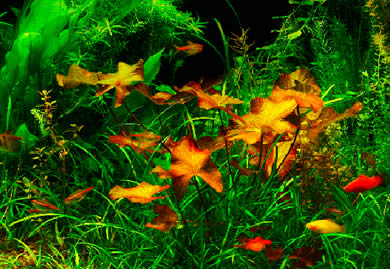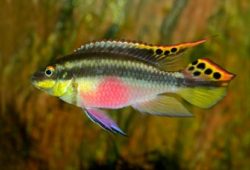Not all water is the same
The title of the article is Not all water is the same. Water for the planted aquarium needs to be very special – more special than for many fish, in fact, and you have three options: tapwater, RO water and rainwater.

With plants, you need to aim for 4-6ºGH and a pH of 6.0-6.9, which you can maintain with CO2 injection.
And when you start your new aquarium, apart from having a decent supply of potassium (probably in with the GH stuff) and micronutrients (so-called trace elements and minerals), the water should, to begin with, be entirely free of nitrate, phosphate and iron.
This last is crucial to avoid your new set-up being plagued with algae.
Plants store immense quantities of nutrients, far more than they need, and having been well fed in the nursery before coming to you, should thus arrive ready primed to start into growth.
However, they can take a while to establish (from a few days to months, depending on variety), and during this early phase, they will absorb little by way of water-borne nutrients – leaving it all for the algae, which you really don’t want!
From the tap
Tapwater may well contain the complete range of plant nutrients, but this won’t significantly reduce the overall cost of conditioning.
Apart from getting rid of the water company’s chlorine and, maybe, chloramine, you have to find out from the company how much phosphate, nitrate and iron it contains (which they are obliged by law to tell you); or carry out your own tests (you will need these test kits anyway to succeed with plants). Phosphate and nitrate will need to be removed.
If you live in a hardwater area, you will have to soften it using either rainwater or RO water as plants do not like hardwater. Never use chemicals to soften your water.
If iron is present, this must also be removed initially. Ironically, once your plants are established and growing well, you will need to add this nutrient regularly.
Incidentally, your water company may well be adding chemicals to increase pH because acid water corrodes their pipework and machinery.
Be aware that all this applies to growing plants, and not to keeping fish. Tapwater may contain an incredible array of additional unwelcome substances which, while OK for plants, may not be OK for every kind of fish. So know your fish and your water.
If I’m forced to use tapwater during a drought, I always run it through activated charcoal anyway.
It really is best to demand a water quality report from your water company, then you can see exactly what you need to add and/or take away.
Make your own?
The next alternative is RO water, which you can buy from many aquatic shops (or you could invest in an RO unit, which is, however, rather expensive). Where I live, the going rate is £2.50 for 25 l. A 500 l. tank of standard shape without condensation covers, kept at 25ºC/77ºF, evaporates around 20 l. a week. So you can work out for yourself which is the more economical route.
Buying an RO unit requires not just the initial outlay (which includes a storage facility and arrangements for pumping into the aquarium unless you want to use buckets and a ladle), but also the cartridges. It also multiplies by ten the amount of water your aquarium consumes.
Typical costs for setting up a 500 l. tank and maintaining it for a year with monthly 20% water changes would be over £100 just for the cartridges.
However, you cannot use RO water on its own as RO water is virtually devoid of all minerals and therefore needs remineralising before using in a tank. Cheap RO units do not remove all minerals and trace elements.
Besides, unless you have very few fish and a vast number of plants, you still have to buy phosphate and nitrate test kits and removal media because these elements are produced by fish 24/7, and need to be very strictly controlled in the aquarium’s earliest days.
Gentle, gentle rain
The third alternative is rainwater. Why people are so frightened of rainwater, I really don’t know – I use rainwater in all of my tanks.
There are two important issues: a non-toxic surface for collecting it, so no tar-covered sheds; and a squeaky-clean water barrel and guttering. I covered my fish-house roof with an inexpensive medium-grade pond liner. My other collecting surface is synthetic slates, though any ceramic or synthetic roof tiles, or real or synthetic slate, will serve quite well.
I use ordinary plastic water butts.
I turned to rainwater because my tapwater contains so much nitrate and phosphate that levels are right off the scales of my test kits.
I don’t use RO water for two reasons. The mains pressure at my house, 700ft above sea level, won’t work an RO unit. Even if it did, in order to fill my 2000 l. tank, I would have to throw away 20,000 l. which, when you are on a meter, is no joke, as well as not being very eco-friendly…
I modify the rainwater in the same way that you would modify RO water, by adding appropriate amounts of hardness constituents – I’ve used JBL, Red Sea and Seachem with success. I also add micronutrients, usually (wrongly) referred to as minerals and trace elements, of which there are now a great many to choose from.
Urban myths?
Everybody’s heard of at least one horror story about rainwater, such as how rainwater is acid, the result of pollution. The fact is that rain is naturally acid, irrespective of pollution, because of atmospheric CO2 and sulphur. We do add to this acidity by our emissions, but nobody seems to be sure by just how much.
But it’s not the acidity of rain that causes damage. One of the most common elements in the earth’s crust is, surprise, surprise, aluminium. This is not a problem so long as soil acidity does not fall below pH 5.5. When it does, the aluminium becomes soluble.
Deforestation, for example, can reduce soil pH dramatically, and when naturally acid rain falls on already acid soil, the soil pH can drop below the magic 5.5, releasing the aluminium and poisoning everything in sight.
The fact that rain is naturally acid is actually a boon for the planted tank keeper, because that is what most plants – and all the most desirable ones – like best.
You may also have heard that rain is unsafe because it has been polluted with man’s many discharges.
Most of our pollution appears to fall on our unfortunate European neighbours to the east and north, because of our prevailing westerly winds, with only around 30% falling on us. Yet no-one ever seems to consider the fact that our tapwater may contain cadmium, lead, arsenic, copper and cyanide, plus a variety of other heavy metals and pesticides, not to mention the occasional coliform and, of course, the nitrate, phosphate and iron.
Barring a catastrophe of Chernobyl proportions, there is no conceivable way in which the worst rainwater can be worse than tapwater, and there are many ways in which it is better. Well, for our purposes anyway.
I might be cautious if I lived downwind of a very large chemical plant. But if you are still unsure, run your rainwater through quality activated carbon for a day or two before you set up the tank. If you live in an urban industrialised area, carry out tests for nitrate and phosphate. You might find some, but it is likely to be less than in your tapwater. A healthy growth of plants will take care of most of it.
I’ve also read that rainwater will promote algae. Well, algae require nutrients, light and CO2, and unless you neglect your gutters and barrel, rainwater by and large has little by way of measurable nutrients when compared with most tapwater.
These are the only options for providing healthy, algae-free water with which to start your planted aquarium. You can, of course, combine all three methods so long as the result is the same: nitrate, phosphate and iron-free water of appropriate KH and pH, with an adequate supply of potassium and micronutrients.
This article was first published in the November 2005 issue of Practical Fishkeeping magazine.



